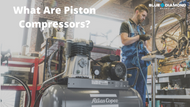What is a Piston Compressor? How Do They Work?
21st Jun 2021
There are two basic principles of air compression, and one of those is displacement compression. Many types of compressors are classified as displacement compressors, one of which is the piston compressor. A piston compressor is the oldest and most common type of industrial compressor.
This type of air compressor uses principles of displacement to increase the pressure of the enclosed volume of gas or air. They are available in a range of configurations, from single-acting, double-acting, oil-lubricated or oil-free. A common configuration is a double-acting design, which features an L-configuration with one vertical, low-pressure cylinder and one horizontal, high-pressure cylinder. The oil-lubricated designs use splash lubrication or pressure lubrication and oil-free designs feature piston rings or toothed walls.
How Does A Piston Compressor Work?
A piston compressor works using a valve system and two stainless steel valve discs. The piston moves downward and draws air into the cylinder, then the largest disc flexes to fold downward, allowing the air to pass. As the piston then moves upward, the large disc flexes again to seal against the valve seat. The compressed air is then forced through the hole in the valve seat and delivered to the end process.
To describe this process in further detail, we have broken down a step-by-step process outlining more of the inner workings of a piston compressor. A piston/reciprocating compressor is a positive-displacement air compressor using a crankshaft powered by a piston and cylinders. The process of compressing air decreases its volume while increasing its density without turning it into liquid.
A piston/reciprocating air compressor works through the following process:
- Gas enters the cylinder through the intake valve.
- The piston pulls away from the intake valve and allows the gas to pass into the cylinders.
- The crankshaft powers the piston, which compresses the gas in one stroke of pressure.
- In two-stage compressors, air travels to a second cylinder for another round of compression. A second piston compresses the gas at a pressure rate of 175 psi.
- Once complete, the compressed air is sent to a storage tank for use.
Reciprocating air compressors provide a compact option to work across a range of industries and deliver powerful compression. Piston compressors come in diesel, petrol and electric powered models.
What Are Piston Compressors Used For?

Piston compressors rely on the reciprocating action of one or more pistons to compress gas within a cylinder (or cylinders) and discharge it through valving into high pressure-receiving tanks.
While the major application of piston compressors is providing compressed air as an energy source, piston compressors are also used by pipeline operators for natural gas transmission.
Piston Compressors are used in the following industries & applications:
Piston air compressors generally are used throughout industry to provide workshop or instrument air; to power air tools, paint sprayers, and abrasive blast equipment; to phase shift refrigerants for air conditioning and refrigeration; to propel gas through pipelines.
How Are Single-acting, Double-acting, Oil-lubricated Or Oil-free Piston Compressors Different?
It's essential to dissect information so be clear regarding piston compressors. There are single-acting, double-acting, oil-lubricated or oil-free variations to these compressors, the differences we will describe in the next section of this article.
The single-acting piston compressors have working fluid enter in one side and push the piston, while double-acting reciprocating compressors have fluid on both ends with a return line. There are oil-free and oil-lubricated piston compressors. Now, to discuss the single acting and double acting elements in more detail:
The single-acting model is the most common compressor, found in applications like small hobby air compressors to trucks in their pneumatic systems - even within a refrigerator. These single-acting compressors are generally oil lubricated, air-cooled with a power output limitation.
The double-acting compressors are different in that they have crossheads that generate a pure strait movement after the crankshaft & connection rod, the technology used primarily in heavy-duty industrial and process compressors ranging from 45KWA upwards.
Technical Working Information about Piston Air Compressors
Piston compressors have a series of versions that correspond to the compressed air demand or the level of pressure required. A piston compressor consists of a crankshaft, a connecting rod, a cylinder and piston and a valve head. The crankshaft is driven via a V-belt, usually by an electric motor.
Generally, most compressors have a compressed air tank to maintain a stable system pressure to the compressed air consumer. The operation of compressed air tools leads to dropping pressure in the tank. When the pressure drops below the lower limit, the motor starts; when the pressure increases back up to the working limit, the motor will switch off automatically. Pressure switches ensure a stable system pressure within the set limits. The pressure in the tank, so the available working pressure, and the function of the on/off switch, indicated by the pressure gauge in the machine.
Why Should I Buy A Piston Air Compressor?
The piston or reciprocating compressor is considered one of the most popular technologies available. This is due to its affordability and economical operational capacities. Gone are days when piston compressors were cumbersome and noisy as they entered a new age of modern reciprocating compressors that hold none of those tired features and are a triumph in modern technology and industrial productivity.
Generally speaking, most small to mid-size compressors range from 0.55 to 15 KW and usually are available as either oil-lubricated or oil-free machines.
These machines are sold with a huge variety of optional extras and product variants, focusing on providing end-users with a wide range of compressors to select. They are typically supplied either as standard base units, trolley or receiver mounted or as a complete compressed air station that includes a refrigerant air dryer and pre-wired starting and regulation equipment. The large style and range of piston compressors are dedicated to particular applications, such as compressed natural gas usage, and can go up to 560 kW.
Advantages and Disadvantages of a Piston Compressors
There is a range of advantages and disadvantages to purchasing a piston compressor.
The technology is cheaper from a practical perspective; maintenance is low, and technicians are easily located, and spare parts (should you need them) are readily available. In comparison, piston compressors can generate high levels of noise and are more susceptible to passing oil into the compressed air supply and must be correctly sized according to duty cycle or generate high levels of heat during operation.
Where to Buy a Piston Compressor?
It's important to ensure you select the right air compressor for your needs. So, if you have any questions or need some help please do not hesitate to call us on 1300 998 647




